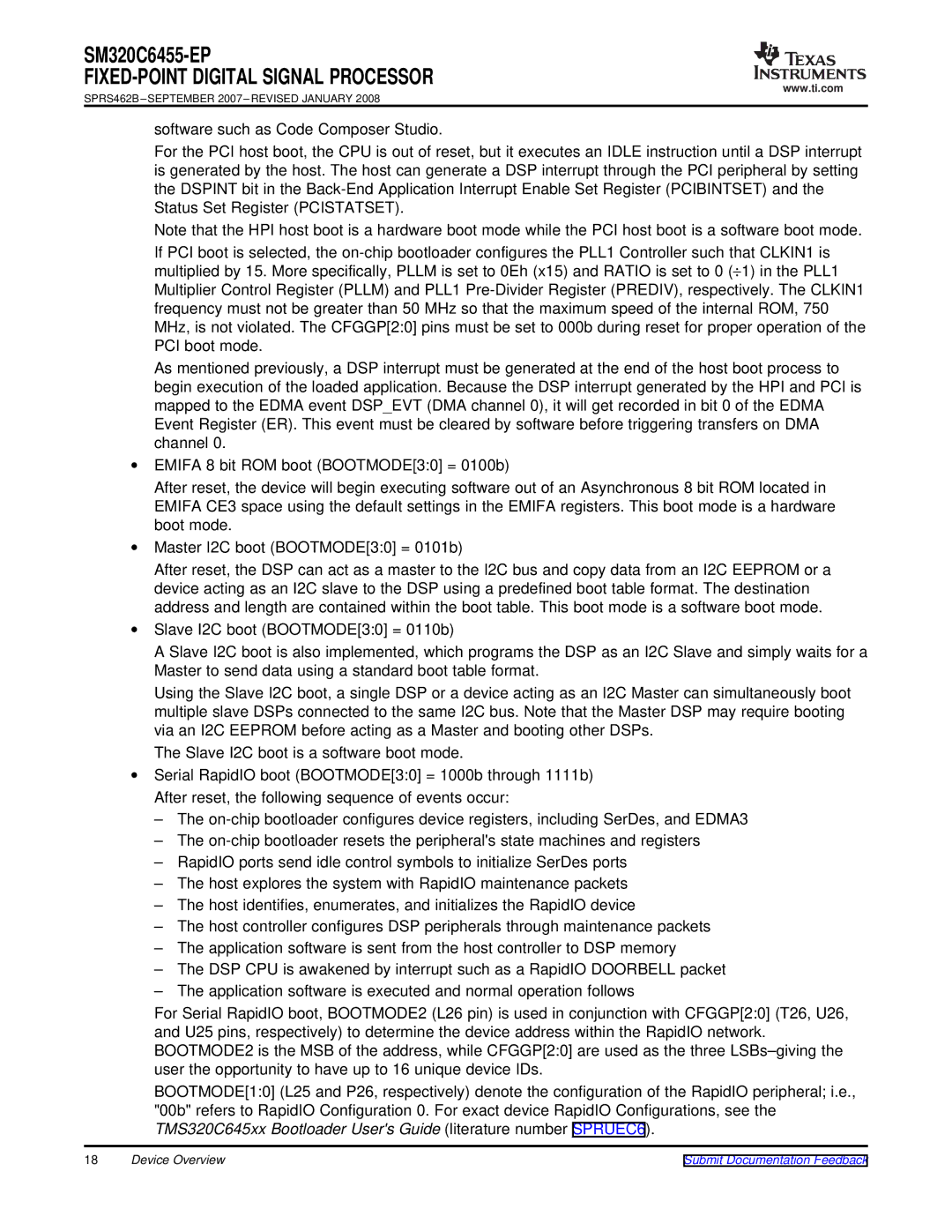
FIXED-POINT DIGITAL SIGNAL PROCESSOR
www.ti.com
SPRS462B – SEPTEMBER 2007 – REVISED JANUARY 2008
software such as Code Composer Studio.
For the PCI host boot, the CPU is out of reset, but it executes an IDLE instruction until a DSP interrupt is generated by the host. The host can generate a DSP interrupt through the PCI peripheral by setting the DSPINT bit in the
Note that the HPI host boot is a hardware boot mode while the PCI host boot is a software boot mode.
If PCI boot is selected, the
As mentioned previously, a DSP interrupt must be generated at the end of the host boot process to begin execution of the loaded application. Because the DSP interrupt generated by the HPI and PCI is mapped to the EDMA event DSP_EVT (DMA channel 0), it will get recorded in bit 0 of the EDMA Event Register (ER). This event must be cleared by software before triggering transfers on DMA channel 0.
∙EMIFA 8 bit ROM boot (BOOTMODE[3:0] = 0100b)
After reset, the device will begin executing software out of an Asynchronous 8 bit ROM located in EMIFA CE3 space using the default settings in the EMIFA registers. This boot mode is a hardware boot mode.
∙Master I2C boot (BOOTMODE[3:0] = 0101b)
After reset, the DSP can act as a master to the I2C bus and copy data from an I2C EEPROM or a device acting as an I2C slave to the DSP using a predefined boot table format. The destination address and length are contained within the boot table. This boot mode is a software boot mode.
∙Slave I2C boot (BOOTMODE[3:0] = 0110b)
A Slave I2C boot is also implemented, which programs the DSP as an I2C Slave and simply waits for a Master to send data using a standard boot table format.
Using the Slave I2C boot, a single DSP or a device acting as an I2C Master can simultaneously boot multiple slave DSPs connected to the same I2C bus. Note that the Master DSP may require booting via an I2C EEPROM before acting as a Master and booting other DSPs.
The Slave I2C boot is a software boot mode.
∙Serial RapidIO boot (BOOTMODE[3:0] = 1000b through 1111b) After reset, the following sequence of events occur:
–The
–The
–RapidIO ports send idle control symbols to initialize SerDes ports
–The host explores the system with RapidIO maintenance packets
–The host identifies, enumerates, and initializes the RapidIO device
–The host controller configures DSP peripherals through maintenance packets
–The application software is sent from the host controller to DSP memory
–The DSP CPU is awakened by interrupt such as a RapidIO DOORBELL packet
–The application software is executed and normal operation follows
For Serial RapidIO boot, BOOTMODE2 (L26 pin) is used in conjunction with CFGGP[2:0] (T26, U26, and U25 pins, respectively) to determine the device address within the RapidIO network. BOOTMODE2 is the MSB of the address, while CFGGP[2:0] are used as the three
BOOTMODE[1:0] (L25 and P26, respectively) denote the configuration of the RapidIO peripheral; i.e., "00b" refers to RapidIO Configuration 0. For exact device RapidIO Configurations, see the TMS320C645xx Bootloader User's Guide (literature number SPRUEC6).
18 | Device Overview | Submit Documentation Feedback |
